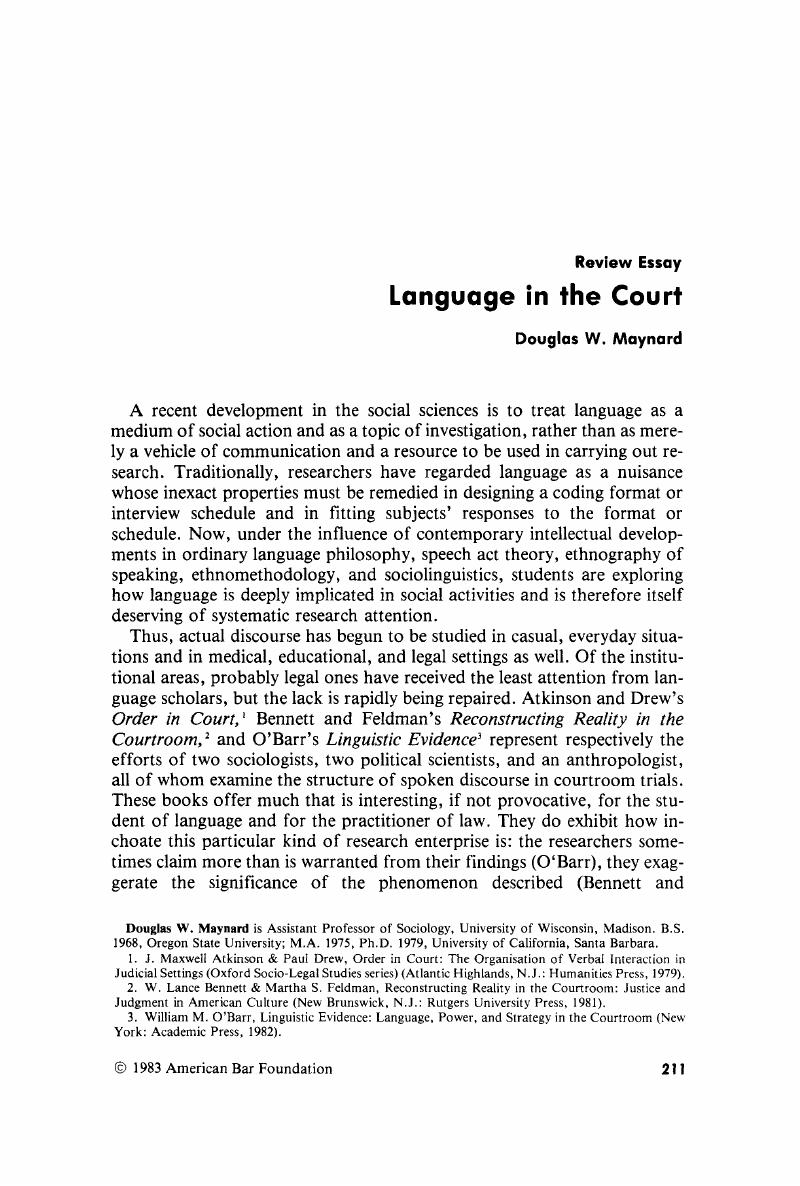Published online by Cambridge University Press: 20 November 2018

1 J. Maxwell Atkinson & Paul Drew, Order in Court: The Organisation of Verbal Interaction in Judicial Settings (Oxford Socio-Legal Studies series) (Atlantic Highlands, N.J.: Humanities Press, 1979).Google Scholar
2 W. Lance Bennett & Martha S. Feldman, Reconstructing Reality in the Courtroom: Justice and Judgment in American Culture (New Brunswick, N.J.: Rutgers University Press, 1981).Google Scholar
3 William M. O'Barr, Linguistic Evidence: Language, Power, and Strategy in the Courtroom (New York: Academic Press, 1982).Google Scholar
4 William M. O'Barr, Laurens Walker, John M. Conley, Bonnie Erickson, & Bruce Johnson, Political Aspects of Speech Styles in American Trial Courtrooms, in 1 Working Papers in Culture and Communication 27 (Philadelphia: Temple University Department of Anthropology, 1976).Google Scholar
5 For a comprehensive review of the literature on courtroom language, see Danet, Brenda, Language in the Legal Process, 14 Law & Soc'y Rev. 445 (1980).Google Scholar
6 Robin Lakoff, Language and Woman's Place (New York: Harper & Row, 1975).Google Scholar
7 See Sacks, Harvey, Schegloff, Emanuel A., & Jefferson, Gail, A Simplest Systematics for the Organization of Turn-Taking for Conversation, 50 Language 696 (1974), who differentiate between simultaneous starts (turn beginnings) and overlap occurring at transition relevance places (turn completions). These are to be further distinguished from deep intrusions by one party into the speech stream of another, which are more clearly interruptive, according to Candace West, Why Can't a Woman Be More Like a Man: An Interactional Note on Organizational Game-Playing for Managerial Women, 9 Work & Occupations 5 (1982).Google Scholar
8 Francis C. Dane & Lawrence S. Wrightsman, Effects of Defendants' and Victims' Characteristics on Jurors' Verdicts, in Norbert L. Kerr & Robert M. Bray, eds., The Psychology of the Courtroom 83 (New York: Academic Press, 1982).Google Scholar
9 Gerald R. Miller & Judee K. Burgoon, Factors Affecting Assessments of Witness Credibility, in Kerr & Bray, supra note 8, at 169, 171.Google Scholar
10 See Maynard, Douglas W., Defendant Attributes in Plea Bargaining: Notes on the Modeling of Sentencing Decisions, 29 Soc. Probs. 347 (1982).Google Scholar